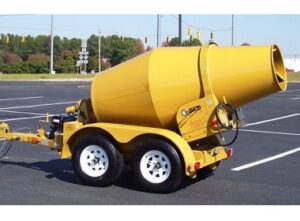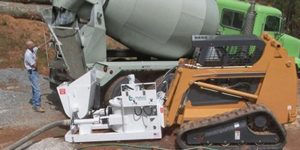
Historically, concrete mixing meant combining sand, cement, lime and water in various ratios to make mortar to apply to building projects. The “recipes” for these mixtures were rarely precise and could change in consistency depending on who was doing the measuring and mixing. Today, preblended materials are more popular, with manufacturers selling dry materials that have been mixed according to calculations to assure the appropriate strength of the final product.
These preblended mixtures become mortar through the “just add water” process, but there are numerous ways to incorporate the water into the dry mix. Each bag of dry mix includes a manufacturer’s recommendation for how much water needs to be added, but the contractor is ultimately responsible for the combination. Traditional hand mixing, batch mixing and continuous mixing give contractors options when choosing how to mix material on the job site. Here’s how they break down.
Understanding the options
Hand mixing is what it sounds like – break a preblended bag of material into a tub, pail or wheelbarrow, add water and mix by hand. The actual mixing step can be accomplished completely low-tech by stirring with a hand tool, or the water and pre blend can be combined using a drill with a mixing attachment known as a jiffy mixer. Most jiffy mixers don’t offer many speed-control options and can be messy to use.
Whether mixing by hand tool or with a jiffy mixer, this option is a slow and manual process, and is not preferred by material manufacturers. When manufacturers develop preblend mixes, they calculate exactly how much water needs to be added to ensure a strong final product. When preblends are mixed by hand, the ratio of wet-to-dry material could easily be off, making it hard for the manufacturer to stand by the strength of the final mix.
Batch mixing is a popular option for preblended material, where the preblend and water are dumped into a basin and churned together to make one batch. There is a wide range of sizes within batch mixing, and most mixers can make approximately 8-12 cubic feet of material in one batch. This process is usually faster and more efficient than hand mixing, though still limits contractors as it takes time in between batches to empty and potentially clean the basin before the next batch can be made.
Similar to hand mixing, the quantity of water added can be a concern in batch mixing. Ultimately, it is up to the operator of the machine to determine how much water is being added to each batch, causing the mixture to vary throughout the day if the operator adds a little too much or not quite enough to any of the batches.
Continuous mixing is a newer option where a machine takes care of both the mixing and the just-add-water step. The operator adds the dry bag of materials to the hopper, then a dosing shaft pushes it into a mixing section where pressurized water is added. The operator can adjust, with a simple valve, how much water is going in at the beginning of each day and the mix will remain consistent throughout the job without measuring or adjusting. Once the mix is created, it can be conveyed to any location – into a pump, a bucket or wheelbarrow – for easy transport around the job site.
By combining “just add water” and “set it and forget it” approaches, mixes will be more consistent and higher quality. The continuous mixer also allows for faster application, as there is no need to wait for hand or batch mixers to complete one bucket or basin at a time.
Which should I choose?
When determining the right mixer for your job, there are a few things to consider.
First, what output do you need to keep your project moving forward on schedule? A continuous mixer can do a pallet of material – usually 35-40 bags – per hour. Compare the output of your different mixing options to make sure you find one with the capacity you need.
Second, consider how portable the machine will need to be, and how that portability meshes with the required output. A hand mixer is naturally portable – as easily as you can carry a bucket and a drill around the job site – but of course it has a lower output compared to both batch and continuous mixers.
Some batch and continuous mixers are portable, and can be transported in the bed of a pickup truck, while some are not. Most batch mixers can plug into a standard outlet or operate with a gas engine, while most continuous mixers require a 230-volt outlet to run.
The key to the decision
Ultimately, when considering your mixing options, the quality of the final material is key. As a contractor, it is a relief to know that the final product on the wall will hold up and have the same material properties the manufacturer has specified. Choose a machine that can be transported around the job as needed and that provides the output required without sacrificing the quality of the final product.















